Posted on September 3, 2021
There has been abundant sea ice in the Chukchi Sea this summer: so much so that walrus herds have not found it necessary to use beaches on the Alaskan coast as resting haulouts. Now, in early September, almost the entire northern Chukotka coast is covered in ice, blocking use of those beaches that have been traditionally used in September through November. Wrangel Island (an important denning area for polar bears) is still almost surrounded by ice, which hasn’t happened in decades.
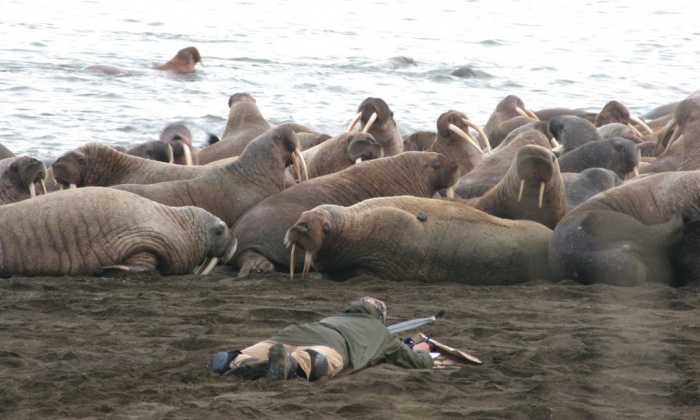
Just two years ago, a big deal was made of the fact that the entire coast of Alaska was ice-free by early August and that walrus herds had come ashore at Point Lay earlier than any year since 2007 – all put down to climate change. Last year, walrus started to come ashore one day earlier than in 2019, on July 29. Although no one has presented any evidence that the walrus are suffering in any way due to using beach haulouts during the ice-free season (MacCracken et al. 2017), the haulouts are still presented as bad news and portends of catastrophe to come.

This year is a totally different story and of course, the biologists are suddenly silent.
Sea ice in the Chukchi Sea this year at 29 July 2021 (below) shows Point Lay was ice-free (as it has been for many years), but we have heard nothing about walrus haulouts as we did in years past.
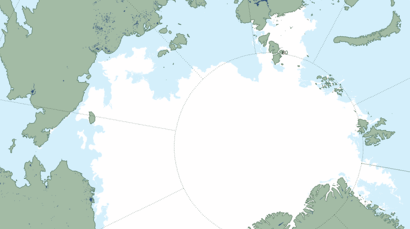
At 31 August 2021 (below) there was not much less ice in the Chukchi Sea and still no sign of walrus at land haulouts in Alaska (Fischbach et al. 2016). Wrangel Island is still almost surrounded by ice and ice covered much of the Chukotka coast on the mainland, including the famous cliff haulout at Cape Schmidt that is the focus of my upcoming book on the deception in David Attenborough’s Our Planet documentary:
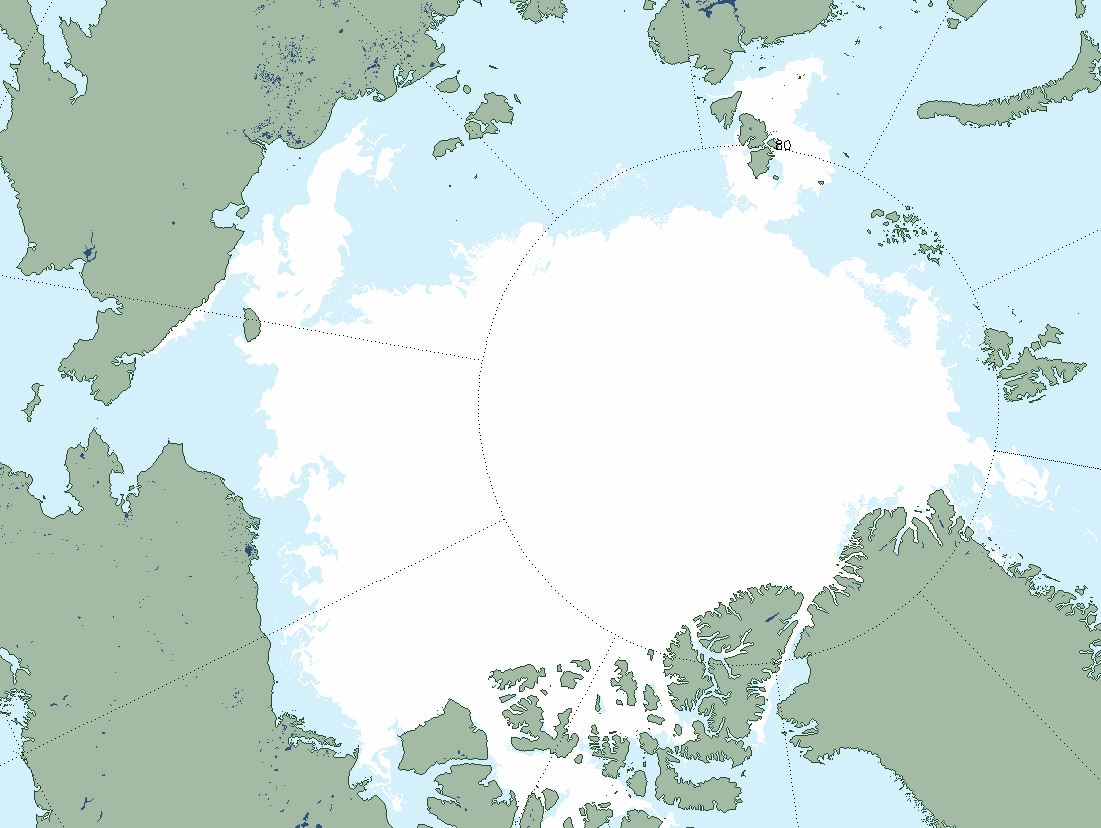
In 2019, there was virtually no ice left in the Chukchi Sea at the end of August:
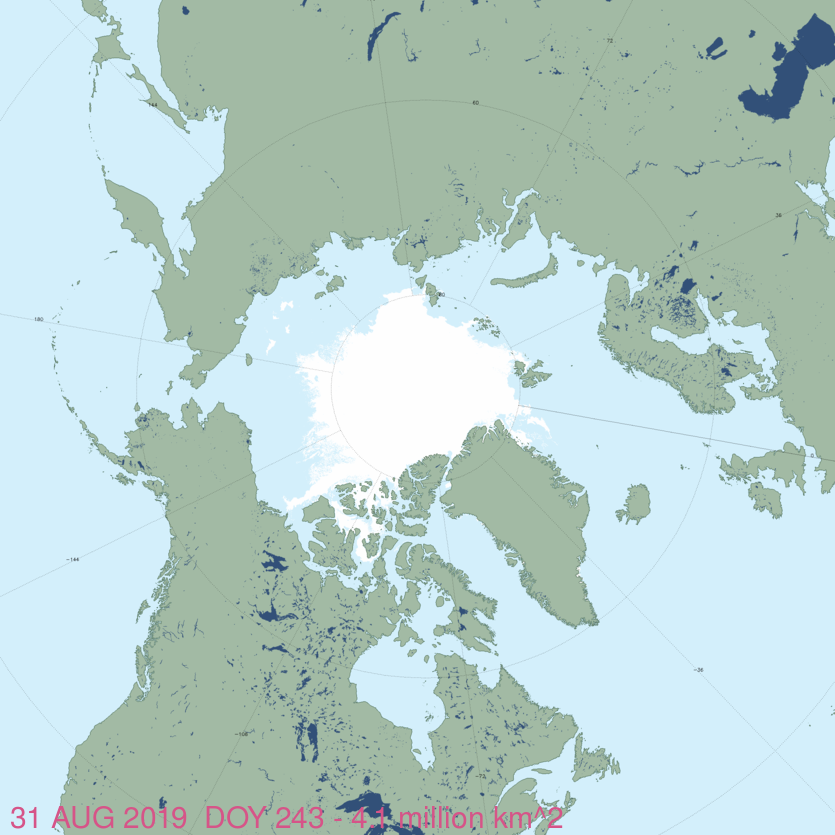
You can see the shallow area of the Chukchi (pale blue) in the chart below for 2 September 2021, where walrus prefer to feed: this year the ice is much closer to these shallow regions and the strip of ice along the Chukotka coast shows clearly.
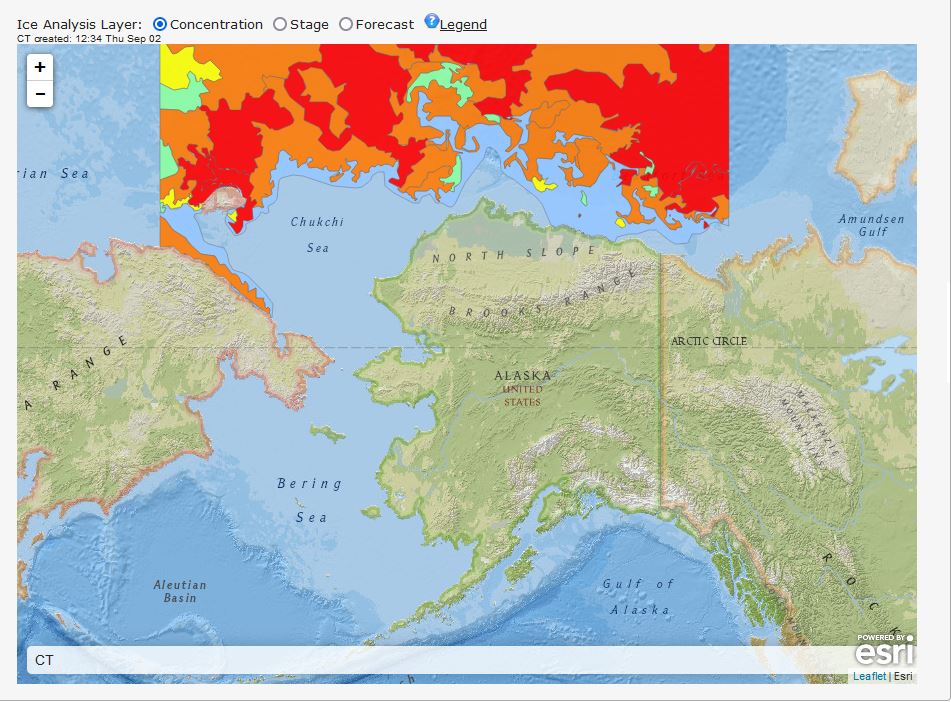
The last time there was ice surrounding Wrangel Island in early September was 2003 but it was only a patch:
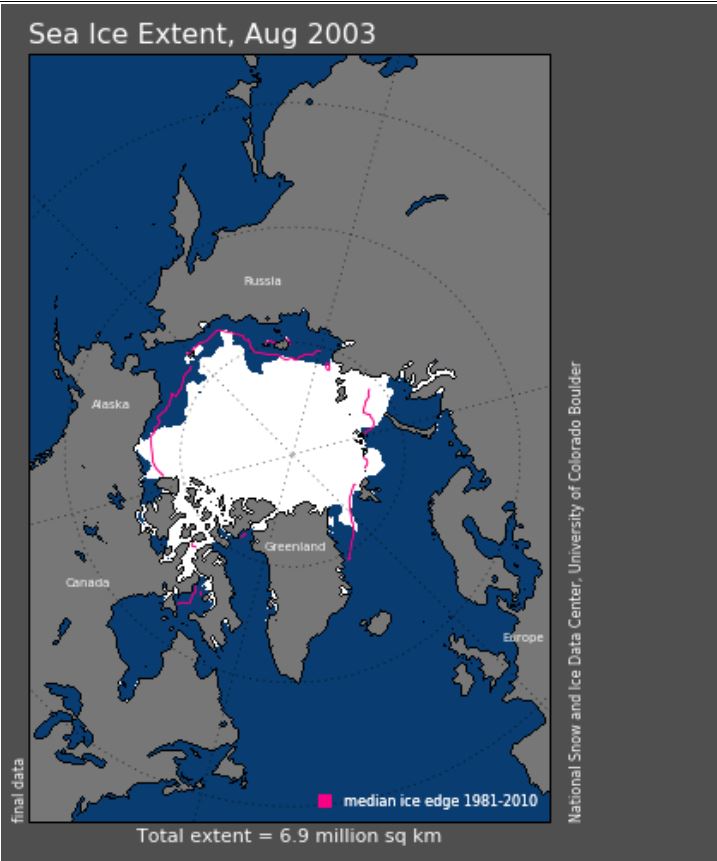
It wasn’t until 2001 that so much Chukchi Sea ice was routine at the end of August:
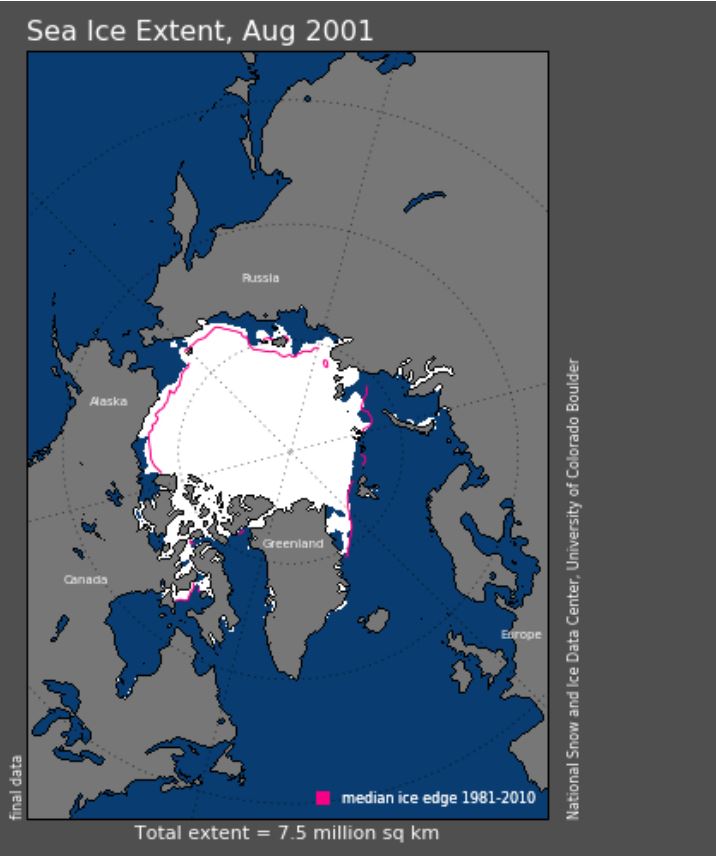
Just for comparison, below is the same chart for 2021 from NSIDC:
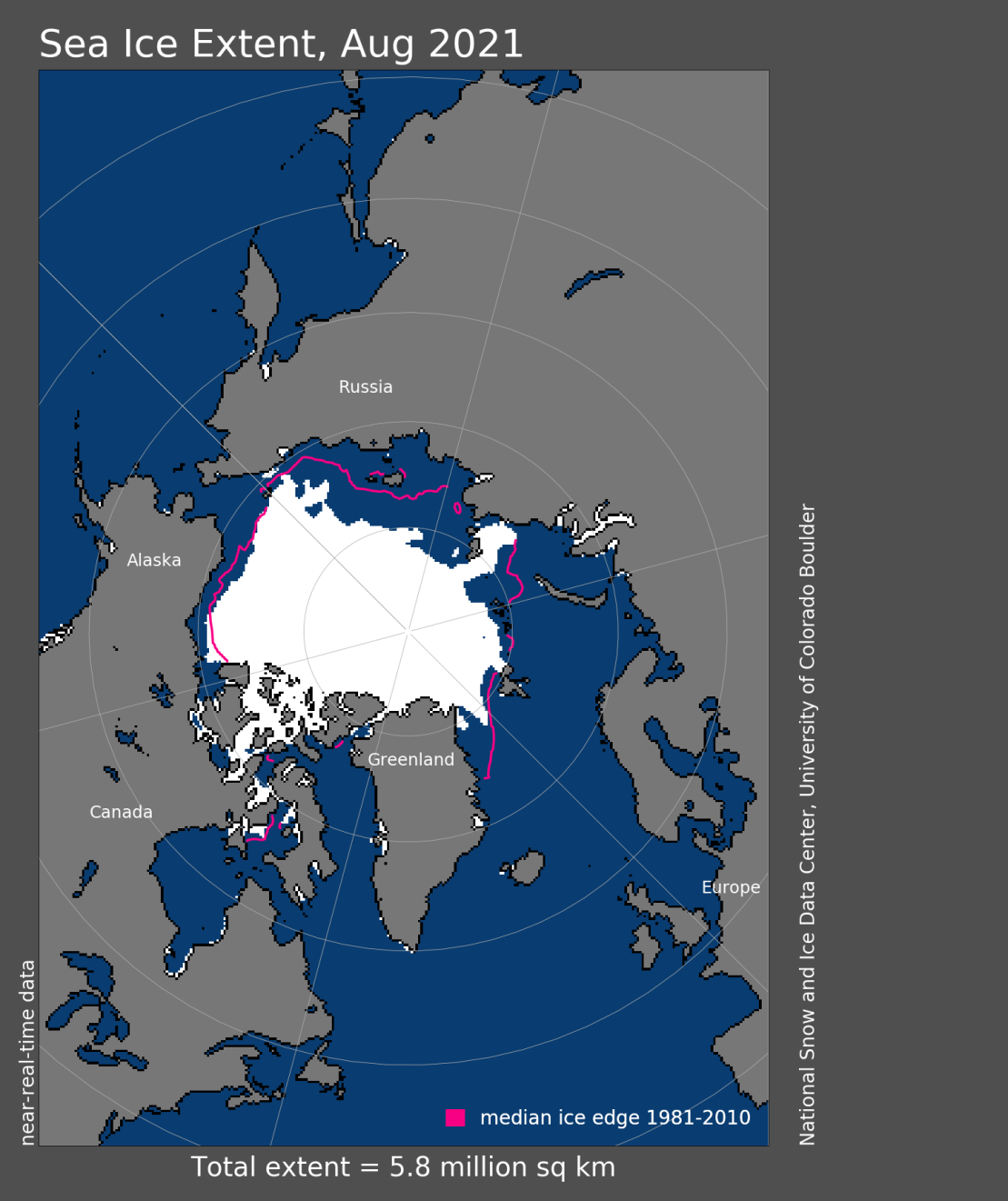
References
Fischbach, A.S., Kochnev, A.A., Garlich-Miller, J.L. and Jay, C.V. 2016. Pacific walrus coastal haulout database, 1852-2016 – Background Report. USGS Open-File Report 2016-1108. DOI: 10.3133/ofr20161108 PDF HERE, download here.
MacCracken, J.G., Beatty, W.S., Garlich-Miller, J.L., Kissling, M.L and Snyder, J.A. 2017. Final Species Status Assessment for the Pacific Walrus (Odobenus rosmarus divergens), May 2017 (Version 1.0). US Fish & Wildlife Service, Anchorage, AK. Pdf here (8.6 mb).
“You can see the shallow area of the Chukchi (pale blue) in the chart below for 2 September 2021”.
None of your charts are showing. There seems to be a problem with posts on this site. Perhaps you should post them in a comment as others have.
Now they have suddenly appeared. Weird things going on
That’s been happening to me lately, but I just hit “Refresh” and then all the images load.
I have no idea why that “Refresh” works or is needed in the first place.
Refresh/Reload is hit and miss. It sometimes loads a few of the charts but do it again and they disappear or another combination of charts are loaded.
Not seeing any charts. That often happens here on WUWT.
Ah, after visiting Susan Crockford’s site, I now get the images loading here.
I suspect this is WP messing around with outside references to images.
I switched over to Susan’s site to see the images.
’cause nothing to see here -climate change
I refreshed the page, viola! all the images show up.
I have tried to refresh 3 times, still no images other than first at top. Have black bar top of screen from wordpress to login, tried that and wordpress is not recognizing me. All the same I am logged in to comment here through wordpress. Does googly or appled own wordpress? That would explain a lot.
Ian Stirling, someone who I greatly respect, says polar bears can’t thrive without enough sea ice at the right time of the year. My reply is that polar bears survived through several prolonged periods in the Holocene when the Arctic was seasonally ice free.
The above article points out that, similarly, walrus are quite capable of dealing with varying ice conditions.
Just because you understand, better than anyone else in the whole world, how critters live under a certain set of ice conditions, that doesn’t mean you are in a position to know what will happen when those conditions change. What we see continuously is expert overconfidence and a lack of humility among a disturbingly large cohort of scientists.
The old joke about PhD education is that you know more and more about less and less until you finally know everything about nothing. The result is scientists who don’t know things that are glaringly obvious to undergraduates in closely related fields. It’s one of the reasons science is broken.
Simple explanation:
“It is difficult to get a man to understand something when his salary depends upon his not understanding it.”
— Upton Sinclair
Or in this case getting wrong in specific direction, more specfically, the direction needed to keep the funding coming, funding that pays the salaries and research work.
“Turn off the alarms, everything’s gong to be okay in Arctic with polar bears, walruses, penguins (sarc), etc.” statement from researchers would send funding elsewhere.
They know this. No different than the bad science surrounding the claims of Great Barrier Reef demise, or ocean acidification claims. That hucksterism and carnival barking by ethically-challenged scientists who’ve become desenstized to their own exaggerations about the future is needed (in their minds) to keep the grants coming.
Grants have been very bad for science in general. As soon as the schools figured out that they could make their professors pay their own salaries through NSF and other grants the system changed dramatically. At many schools professors no longer teach classes, their primary job is writing proposals to secure their salaries and enrich the school that generously provides them with labs and offices. And no one seems to see anything wrong with this.
Most classes are now taught by Grad students, or recent PHD graduates who are hired on a temporary basis, virtually paid by the hour, with no future career prospects at all.
Yes, the Adjunct Professor. These poor souls go from semester to semester and never know their fate until they are told it is over. The pay is abysmal and they are at the lowest rung of academic life.
As a grad student, I did my share of teaching and didn’t really mind, it is a useful skill to acquire.
As an undergrad, such practices didn’t bother me much. The only problems came when the grad student was a foreign national with an accent so thick as to make his/her words indecipherable.
“…their primary job is writing proposals to secure their salaries…”
Same for the elected in the US CONgress except they have lobbyists to write for them
Don’t get me started on Congress! The best thing for America would be to fire all of them and start over with term limits, serious term limits. There are too many in Congress now that have never had a real job and are totally out of touch, only interested in the power their office gives them. It is long past time to banish the professional politician and go back to people serving in congress for a limited number of years for the betterment of the nation. As it stands now, they are only interested in feathering their own nests and tossing goodies to their friends. Get rid of those lifetime-pensions too! Nobody should serve in Congress long enough to accumulate a lifelong pension!
Tyranny of the Bureaucracy seems the to me the larger problem.
The vast majority of the covidiot regulations are written by unelected bureaucrats seemingly untouchable by anyone.
The same people who declare that merely being in the same room as someone with “oil money” is disqualifying, will then turn around and declare that there is nothing wrong with prostrating yourself to get “research grants” paid for people who have intense financial interests in which way your “study” leans.
Right you are Mark. How about all those people who told us sugar was perfectly good food and that we should just avoid saturated fat? I wonder how knowing they are responsible for the obesity epidemic sits with their sense of ethics.
“ How about all those people who told us sugar was perfectly good food and that we should just avoid saturated fat?”
Who was that & when?
I can’t recall ever hearing that at any point in my life, that sugar was “perfectly good food”.
When jogging became a hot trend, followed by triathlons, there was a lot of talk & ink about *complex* carbs & hydrogenated fats.
Saturated fats were something those with high cholesterol were supposed to limit, especially if the HDL-to-LDL ratios were outside certain ranges.
What exactly is the point?
Just because you have some rainy periods doesn’t mean you can’t have drought.
Just ask Texas.
It was noted months ago there’s more sea ice in the area than any year since 2015.
Ice free periods in summer aren’t expected to happen until the 2040s.
Perhaps walruses can adapt but their numbers were perilously low in the 1960s until human intervention caused a rebound.
Has anyone mentioned that ice caps & glaciers should see a dramatic rebound over the next decade since we’re in the foretold period of Die kalte Sonne?
Just hope that rebound doesn’t reach a ‘Tipping Point’ and push us into the next glaciation… That’d drive ’em nuts :<)
Historically haven't 'Tipping Points', if you want to call 'em that, worked in both directions, popping the world both into and out of glacial stages. Actually, at this point in the current interglacial I'd bet the probability of a new glaciation is a bit higher than one the other way.
“I’d bet the probability of a new glaciation is a bit higher than one the other way”
on what timescale?
The figures in this article and many recent articles do not appear on my IPad or IMac machines.
Arctic sea ice will be substantially higher at this years minimum than it was in 2007 when Al Gore and IPCC got a Nobel Prize for Politics and everyone was screaming about “runaway melting”, “death spirals” and “ice free summers”.
MORE sea ice 15 years later, pretty much DESTROYS these fanciful claims.
Oddly scientists and journos are silent about what was once “the canary in the coal mine”.
Don’t forget the Cop-Out clause will be the fall back position when they claim, “we were basing our opinions on the best available science at the time!”.
They always have a ready excuse as to why their previous predictions of catastrophe & disaster didn’t happen!!! That’s why they need more funding to carry out more research!!!
2007 was a dramatic decrease over previous years; at the time causing disbelief in both camps.
How long before we see a return to the sublime sea ice extents of coverages typical of the late 90s& early 2000s, before Icecap Al’s alarmism took root?
I’m confused. I thought we were supposed to root for the polar bears. If walruses haul out on land they’re easier prey for polar bears, right? But if they haul out on sea ice, polar bears go hungry. So which one is your poster child, climatistas? Choose one.
I know Susan Crockford would correct me on polar bear diet (baby seals in the spring). Just illustrating the loopy logic of the climate crusaders.
The climate crusaders are incapable of logic. That being the reason that they are “climate crusaders” to begin with.
They aren’t incapable, they just don’t find it politically useful. Besides, ‘logic is racist’. (sic) Which is a claim they do find politically useful.
The old conundrum: What do you do when you see one endangered species eating another?
The Walrus and the Carpenter By Lewis Carroll
Well yes: after being at 3rd lowest in June, the ice had a respite in July and in some areas is much higher than in recent years…
(but not for example in the Laptev or N of Greenland).
But the ice extent is largely high due to high dispersal – and in the future we are likely to see the downward trend continue.
One year of respite for the walrus – but that doesn’t change the future impacts on their populations.
Griff, mate
Go to NSIDC’s website.
You will see sea ice in the Arctic is as near as dammit in the interdecile range.
Antarctic sea ice is well above average
Which is why griff quotes ice for the Arctic only, June only, and only under a full moon.
He’s barking
” … and in the future we are likely to see …”
In the future, we are likely to see EVERYTHING, griff!..
Why don’t you stop using “pauses”, “hiatuses”, “respites”, and other hokus-pokuses and start to STUDY the geologic history of the planet?
Yes, I undestand that your intelligence is in a respite but this is an idea very simple to grasp…
griff has been proclaiming that the arctic has entered an unstoppable death cycle since at least 2012.
It still hasn’t happened, but it’s going to, any day now.
There is a trend in the ice extent, Griffy – but it’s not going downward. Your post is delusional, as usual, and bears no relation to reality. In the real world, sea ice reached it’s lowest extent several years ago and is now recovering nicely. Aren’t you pleased to see that your fears are groundless? Aren’t you overjoyed that the ‘Arctic death-spiral’ hasn’t happened? Aren’t you just chuffed to bits that disaster has been averted?
The extent is very important but is not the only factor.
The coverage per unit area as well as the thickness are also very important.
15% coverage at 1m thickness counts the same as 100% at 3m thickness as far as extent goes but are very different in terms of total ice & heat retention.
So, you admit ice is no problem…
“One year of respite for the walrus – but that doesn’t change the future impacts on their populations.”
What future impacts would they be? Have you got your crystal ball handy?
Your cut&paste skills have certainly failed of late, your lie spew used to be entertaining. Now we are bored with your lie spew and wish you would simply self exterminate.
in the future we are likely to see the downward trend continue
We may. Or we may not. It’s anyone’s guess since we only have a few decades of data, but it should be no surprise if sea ice does decrease further. Paleoclimate data shows sea levels were 4 to 6 meters higher 125,000 years ago during the peak warm period of the prior interglacial, suggesting it was warmer and there may have been less sea ice. It certainly wasn’t caused by humans and no one knows if CO2 had any impact. Nature does its own thing. We’re just along for the ride.
that doesn’t change the future impacts on their populations
What impacts, exactly? There’s no evidence that land haulouts reduce their population significantly. They’ve been around for hundreds of thousands of years and survived several interglacial periods when presumably there was less sea ice. The biggest threat to their population was hunting by commercial sealers and whalers which was stopped. Just like with polar bears, their population rebounded after hunting was restricted.
The only downward trend we are likely to see is the quality of the guff that griff posts.
Spout nonsense – rinse – repeat.
You’re stuck in a rut, even when numbers are increasing you can’t admit it. Your knowledge of this and many other subjects is seriously lacking.
Anyone else notice how griff has been forced to slice the data finer and finer in order to find something that he can trumpet as proof that CO2 is going to kill us all.
Yesterday he was going on and on about strong hurricanes, but only those that struck the coast of Louisiana.
Worth quoting the NSIDC report for August:
By the end of the month, large areas of the Beaufort and Chukchi Seas were covered by low concentration ice (25 to 75 percent; …; some of this ice may yet melt away or fall below the 15 percent concentration threshold adopted for calculating ice extent. Many other areas have unusually low extent, such as Fram Strait and north of Svalbard and Franz Josef Land. As noted in our July post, open water persists north of Greenland in the Wandel Sea, an area that has rarely been open in past years. A small area of ice persists in the eastern Kara Sea.
Note some parts of the chukchi will only have 25% and less coverage.
You shouldn’t be quoting them griff. You should be angry as hell at these people, who are unashamedly trying to turn people like you into vegetables – and succeeding.
Would a vegetable be able to know that it’s a vegetable?
Griffy this post is more delusional than most that you have come up with. Low sea ice being in the 25-75% range? That’s a seriously wide margin of error – they’re really covering all bases. Note that according to your delusions and they alone, the ice will suddenly reverse course and we WILL sea an ice free Arctic – despite the real world observations that show that the lowest sea ice extent was several years in the past and, each year since, we move away from that point and towards more ice coverage.
All of the indications are that the warming we saw in the 80’s has stopped and that we are in a cooling world – I take no pleasure in that; cold kills far more than warmth does, but we all need to face reality and be prepared for cooler times.
Damn – missed a typo. Sea for see. Apologies.
I gave Wally the Walrus a call and he said their greatest worry is not ice conditions but rather Sir David returning with those killer polar bears…Wally says those bears become cannibals when starving….and ugh…adults will eat their cubs. There is a walrus in a zoo somewhere that “sings” for food…unbelievable sounds.
And yet it is still covered with ice. Your sad attempts to spew lies are quite sad anymore.
Griff, you should not be posting as you have not apologized to Dr. Crockford.
With North Atlantic cooling in the last decade, and weakening of the Gulf Stream,
Exceptional twentieth-century slowdown in Atlantic Ocean overturning circulation | Nature Climate Change
then recovery of Arctic ice is hardly surprising.
The Guardian has gone for the “warmer Arctic causes colder winters” angle..
The new report, titled Linking Arctic variability and change with extreme winter weather in the United States, has helped to clarify that connection.
Its authors argued that this type of Arctic change actually increased the chances of tightly spinning winds above the North Pole, known as the Arctic stratospheric polar vortex, being stretched and thus boosting the chances of extreme weather events in the US and beyond.
“I know it’s very counterintuitive, and I think that’s why there’s a lot of resistance and hesitancy to our idea, right?” said Judah Cohen, one of the paper’s authors. “Because how could making the Earth warmer lead to more extreme cold? But that’s what we’re arguing.”
https://www.theguardian.com/environment/2021/sep/02/climate-crisis-extreme-winter-weather-events-report
No word on ice extent or the fauna. Which obviously means good news!
It is gradually dawning on Guardian journalists that they have, yet again, backed the wrong horse with Global Warming. It will be fun to see how they try to explain this away.
The Guardian – never knowingly right about anything.
So, not only is the Polar Bear hunting going to be awesome, so will the walrus hunting. It is great being top of the food chain.
I hope that narwhal hunting is off limits because they may be endangered. I have seen a picture of orcas sticking their heads up above the water to spy seals lying on an ice floe…if orcas invade the arctic, polar bears may have another problem….. unless orcas don’t like hairy food.
That whole top of the food chain thing can be ugly, no matter how cute those mammalian fish are. As for narwhales, successful species rise and unsuccessful species fall, just how the game is. Enough laws and regs governing taking of game, just enforce them on everyone equally, such as stopping China from raping every fishery on the planet. Wonder when that will be done?
Silly…it’s only climate change if it fits the narrative.
And an astounding number of people trained as scientists are silent on this…
I know a lot of scientists like that, but they deliberately stay in the comfort zone of ignorance (to quote someone from a day or two ago) in order to have a more peaceful existence. Sometimes, I wish I could do that.